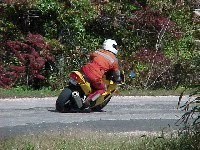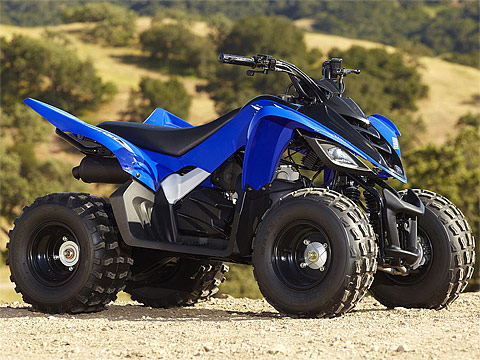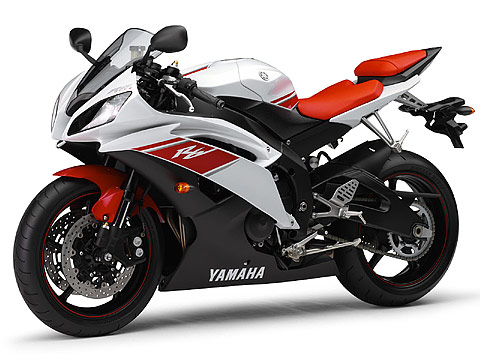The Fundamentals
Sometimes when you're teaching someone how ride a motorcycle it's easy to forget to teach him or her to stop one. It's easy to forget that stopping is as important as starting, and for the beginner, it can be nearly as difficult a skill to master.
 Using the brakes on a bike is much more challenging than using the brakes on a car. A rider must use both hands and both feet at the same time to stop a motorcycle. In one motion, the rider must pull in the clutch lever with the left hand and squeeze the front brake lever with the right, while shifting down to first gear with the left foot and pressing down on the rear brake pedal with the right.
Using the brakes on a bike is much more challenging than using the brakes on a car. A rider must use both hands and both feet at the same time to stop a motorcycle. In one motion, the rider must pull in the clutch lever with the left hand and squeeze the front brake lever with the right, while shifting down to first gear with the left foot and pressing down on the rear brake pedal with the right.The front brake is the more important of the two brakes. An average motorcycle relies on the front brake for 70-to-80 percent of its stopping power. Bikes with long wheelbases and a more rearward weight distribution (like cruisers) rely more heavily on their rear brakes than bikes with shorter wheelbases (like sportbikes) but even on a cruiser, it is the front brake that does most of the work when stopping.
Contrary to persistent mythology, a motorcycle will not flip over accidentally if the rider uses the front brake. On modern sport bikes, it's possible to raise the rear wheel by applying the front brake--this stunt is called a "stoppie"--but to do this requires a good bit of skill and practice. It also beats the living daylights out of your motorcycle.
It's important to develop a feel for what your brakes are doing so that you can apply the appropriate force for a given situation. You don't want to squeeze the brake lever or press the brake pedal too hard, or you'll lock up your tires and skid. This is especially true of the rear tire, which locks up more easily than the front tire, especially on modern motorcycles, most of which are equipped with rear disc brakes. According to a report issued by the California Highway Patrol in the mid-1990s, a rider locking up his or her rear brake is a factor in the majority of all the crashes they investigated.
Locking up the brakes is Not a Good Thing. When your tire is sliding, it drastically reduces traction and braking efficiency while drastically increasing your odds of crashing. If your rear tire starts to skid, there's a good chance you'll either low side the bike (slide down on the road and crash), or high side the bike (start to slide one direction, then flip over in the other direction). A high side, the worst kind of single-vehicle crash you can have, happens when the rider releases the brake while skidding. This allows the tire to regain traction, jerking the motorcycle in the opposite direction.
The best technique to use for a skidding tire is to not skid the tire in the first place. If you do so accidentally:
- Rear-wheel skid: keep the rear wheel locked until you're completely stopped, keeping your eyes focused straight ahead and not at the ground. Exception: if you skid the rear wheel on a poor surface like gravel, it is possible to regain traction by gradually easing up on the rear brake pedal. The key there is gradually.)
- Front-wheel skid: release the front brake and then reapply it immediately, being careful to squeeze the front brake lever and not "grab" it.

Two Wheels Versus Four Wheels
Riding a two-wheeled vehicle involves all sorts of weird chassis dynamics, dynamics not experienced in a four-wheeled vehicle.
The relatively small amount of rubber in the contact patch of a motorcycle tire means a motorcycle has less traction available than a car. Plus, unlike cars, motorcycles lean when they turn. As your motorcycle leans, the available traction changes: this means you have less traction available in a turn. Anyone who has watched much motorcycle road racing has probably seen more than a few racers crash because they applied the brakes while leaning over in corners.
To further complicate matters, when you accelerate, decelerate, or brake, you upset the chassis of your motorcycle, causing it to move around. Not only does this distract you, it varies the amount of pressure on your tires, which in turn varies your available traction.
- Because of the physics involved with riding a motorcycle, you should get your braking done before you turn. Apply the brakes when the motorcycle is upright, before you lean over to turn. If you brake when you're leaned over, you're much more likely to skid than you are if you brake when the motorcycle is upright. Remember, when you're leaned over, you have less traction available.
- If you are going too fast and need to slow down in a corner, the best technique is to stand the bike up for a brief moment, brake hard in a straight line, then immediately lean back into the curve. If you do this for more than a split second, you will run off the road, which sort of defeats your purpose. Your best technique is to not enter the corner too hot in the first place.
Braking Practice
Locking up your brakes is a very dangerous situation. To help avoid it, practice stopping quickly in a parking lot or other area free of traffic and obstacles, being careful not to lock up the tires. While riding in a perfectly straight line, practice applying the brakes right up to the point of locking your tires. Make certain to give yourself plenty of room so you can decrease the brake pressure should you start to skid, yet still have enough space to safely stop. Remember, the point is to perfect your skills should an emergency situation arise, not create an emergency situation.
During this exercise you will most likely skid the tires, but if you are going perfectly straight and don't panic, it should prove harmless. And if you do panic and fall down, of course you will be wearing proper safety gear, so most likely you won't be seriously hurt. This practice will give you a sense of where the limits are in an emergency braking situation, allowing you to stop in the most effective manner.
Only after you are comfortable with your ability to feel what the tires are doing through the brake lever and brake pedal should you venture out on public roads.
Advanced Practice
Even after you master braking, you need to constantly practice emergency stops. Find a place with no traffic or obstacles and practice stopping as hard as you can. First practice stopping using just the front brake. At the slightest hint of the front tire locking up, release the front brake. Once you know the limits of your front brake and can instinctively apply them forcefully and quickly, begin adding a small amount of rear brake at the same time as you apply the front brake. Remember, the front brake does most of the work, and the rear brake locks the tire up much easier than the front, so you won't apply nearly as much pressure to the rear brake as you do to the front.
Tips
Cover Your Brake Levers
While riding in any kind of high-risk area (which describes most places you'll ride), always cover your front brake with at least a couple of fingers--that is, ride with at least two fingers resting on your front-brake lever. Also, make certain your foot is in position to use the rear-brake pedal. Having your hand and foot in position to stop will give you an extra fraction of a second to stop, which, if you haven't figured this out by now, can mean the difference between life and death.
Antilock Brake Systems
ABS stands for Antilock Brake System. ABS systems on motorcycles operate much like those on cars-sensors detect when a wheel is not turning, and release pressure to the brake on that wheel, preventing a skid. Under normal conditions, a rider can do this without ABS, but in an emergency, it's a good feature to have, and can save your life.




0 Comments